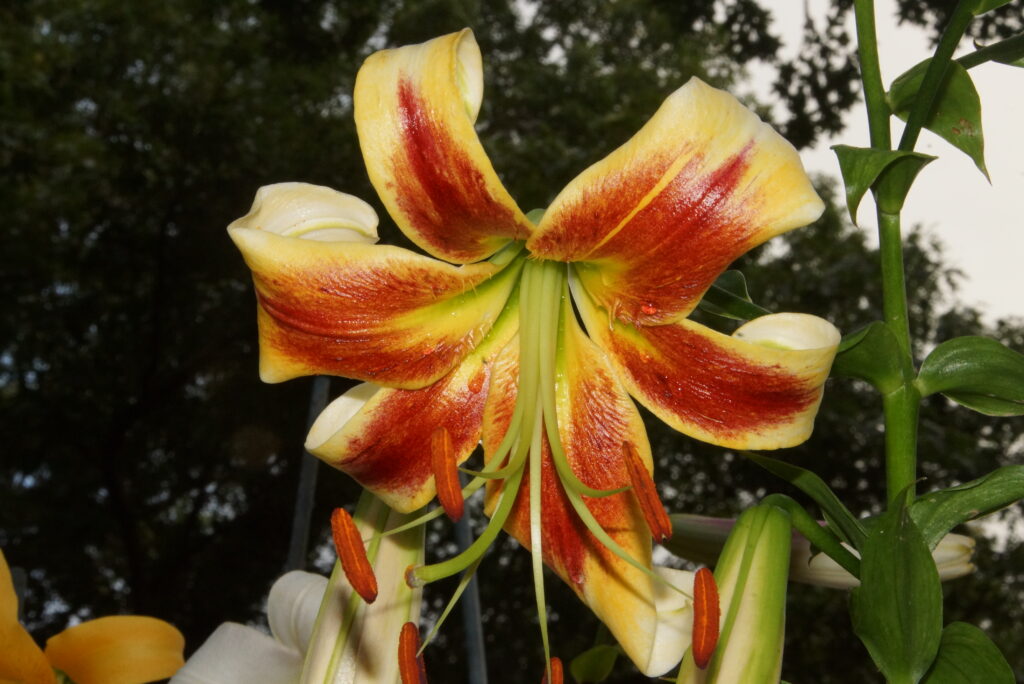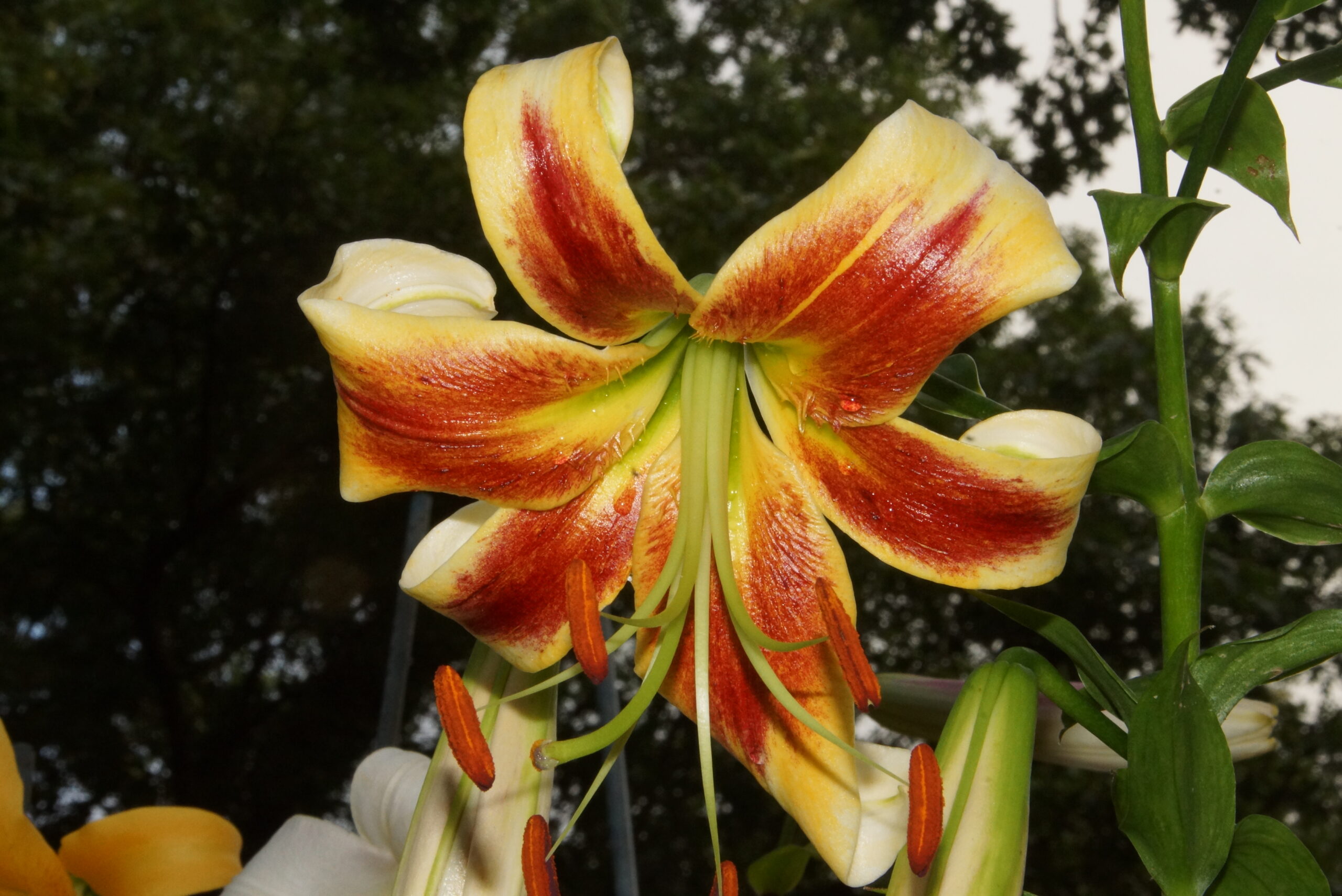
Arthur F. Evans, D.D.S.
Director, North American Lily Society
P.O. Box 186
Gravette, AR 72736
First, let me assure you that I’m talking about the genus Lilium and not the genus Hemerocallis. I have no bone to pick with that other genus or with its devotees, but it is tedious when I say “I grow lilies,” for people’s faces to brighten up as they exclaim how they just love “Daylilies,” too. Their brows invariably furrow in confusion when I say “no, I grow the true lilies.” Then I’m into a 15-minute discourse about the 25-30 plants that are called “lilies” as part of their common name, which are only distantly, if at all, related to the genus Lilium. Thank goodness I don’t need to do that for this group since we only have 30 minutes.
I’ll also dispense with a discussion of the species lilies since most of them are at best difficult to grow in average garden conditions. The modern lily hybrids, however, are much easier and much more rewarding as dependable, high-performing, star-quality perennials.
We are at the Southern edge of the areas where lilies grow to perfection. Most are grown in the Northern US and Southern Canada. Obviously, winter hardiness is not a problem here. Lilies grow like weeds where people have to bury their water lines 5′-7′ deep. Our soil seldom freezes down to the level where the bulbs are. That is actually a problem because they tend to come up too soon in Spring, and they get frost-nibbled. Further North the soil stays cold enough to keep the shoots dormant until it really is Spring. Shoots start emerging here in mid-March. To avoid frost damage, apply mulch in increments to cover precocious shoots until the last expected Spring frost, around here about the first week of April.
Most lilies like full sun and will tend to lean toward the light if planted in shade or against a wall. The taller types often need staking, particularly if they are heavy with buds or if you have overused the nitrogen fertilizers. The Oriental lilies are the exception to the full sun rule. They evolved on cool, moist, volcanic slopes, of which there are precious few in Arkansas. They are the most beautiful but tend to die quickly in our hot summers and fusarium infested soil. Grow them in pots in a cool greenhouse, or at least provide afternoon shade.
Most lilies prefer slightly acidic soil, pH 4.5-6.0, with extra peat and sand worked in. In their natural habitat, the species are often found in open pine forests among Rhododendrons, Azaleas, and Hollies. Most lilies evolved on fairly steep slopes in Europe, Siberia, Northern China, and Japan. They absolutely demand perfect drainage. My best plants grow in raised beds. If a soil will grow good root crops, such as carrots & potatoes, or even corn, it will probably grow good lilies as well. They suffocate in clay soil, but revel in an organic sandy loam. Lily roots need air. There is even one species, Lilium arboricola, which grows like an orchid in the crotches of rainforest trees in the Philippines, hundreds of inches of rain, but perfect drainage and air around the roots. Normally we get about 45 inches of rain and that’s usually plenty, I seldom water my lilies except in severe drought when the plants are trying to grow seed pods. Frankly, its easy to over-water them, especially if they are in tight soil, and growing in level ground.
When watering lilies, use the soaker hose, not a sprinkler. Water on the foliage which does not dry by nightfall promotes botrytis leaf and flower blight. It’s hard to avoid in our climate, especially, if the early foliage has been damaged by late frost. I have tried any number of fungicides, none of which gave perfect control of botrytis problems. Botrytis is a leaf disease, but the spores live over the winter in dead leaves on the ground. You can reduce early Spring re infection of the new leaves by cleaning away the current year’s stalks as soon as they start to turn yellow in late summer and fall. Adding a new layer of mulch in Spring will also help to avoid rain splattering the infectious spores from the soil surface up onto the new leaves.
There are lots of good mulches for lilies, everything from hardwood sawdust to rice hulls to pine needles to cottonseed hulls to shredded leaves. When thinking mulch, think light, non-packing and easily permeable by our old friend AIR! Lilies love mulch, but unfortunately, so do mice and voles who love to eat lily bulbs. If you have rodents, use a minimum of mulch or you will be replanting every year. My raised beds are lined with half-inch hardware cloth to keep Mickey and Minnie away from the most precious breeding stock.
If you use chemical fertilizers use low-nitrogen formulas like Propell 6-24-24. I use chemicals and organics, generously. As both a soil conditioner and a source of micronutrients, I till in at least an inch of alfalfa pellets before planting a new bed. After planting, especially in Spring, I use another half inch or more as mulch. I have no problem with organic gardening as it applies to building a rich, moisture retentive, well drained, well aerated habitat for lily roots, but fusarium loves that habitat, too, and remains viable as a pathogen for at least 5 years after it has killed the lilies planted there. The only real defense is to plant varieties of lilies that are proven resistant or tolerant to the disease. Commercial lily bulb growers have the luxury of renting new fields which have not grown lily bulbs before for each 2 year planting. Gardeners don’t have that luxury. We soon run out of new soil. Over time we find out which lilies will tolerate a buildup of warm soil pathogens like fusarium and anthracnose.
In our area, the best-adapted lilies are the Chinese trumpets such as the Regal Lily and the Aurelian hybrids which are crosses between the trumpets and Lilium henryi. They bloom in June and July, and they don’t mind hot summers. Many gardeners also do well with the Asiatic hybrids which bloom here from Late May into early July. There is a very good color assortment, but there is no blue in the genus Lilium. God, I hate it when florists dye lilies blue.
It’s all the rage now to soak stems of white lilies in dye solution to match the bridesmaids’ dresses. That’s not gilding the lily, that’s gelding the lily and we hates it Mr. Baggins.
Lily bulbs are best bought and planted as soon as possible in October and November. For freshest bulbs (very important) and best selection get them from a local lily Society Fall bulb sale (which you don’t have, but Springfield, MO, does) or a lily specialty catalog of which there are several. If you see a bulb in a garden center or worse yet, the garden department of a department store, it has probably been poorly stored and would be unlikely to perform well for you. Lily bulbs are never completely dormant like a tulips or daffodils. They dry out and die. Freshness is essential. If you receive fresh bulbs and can’t plant them immediately, keep them in the refrigerator at 35° F until you can plant them outside.
It takes 2 or 3 years to get a blooming lily from lily seed, and only the better gardeners are that patient. I see quite a few of that kind in the audience today, so if you would like to flex your creativity with a truly magnificent genus, please talk to me at lunch about hybridizing lilies, my main gardening obsession. My breeding involves the new group of hybrids called “Orienpets” which combine the beauty of the Oriental lilies with the garden adaptability of the trumpets. These new hybrids will extend the area where lilies can be grown deep into the South and Southwest. They are knockout beauties which dominate the landscape in their season. Once you grow them, you won’t be able to get enough of them. Shall I tease you with a few slides?
Before we break for lunch, let me plug the North American Lily Society, the only international group in this hemisphere devoted to Lilium. We have an annual international show (Boston this July), yearbook, Quarterly bulletin, Seed Exchange, library, slide shows and a host of other member services for the reasonably low price of $20.00 a year. Also the Ozark Regional Lily Society centered around Springfield MO, has a show and Quarterly cultural meetings and bulb sales. See me later for sources of the best lily bulbs.
——————————————————————————–
©Copyright 2002 Arthur F. Evans, D.D.S.
